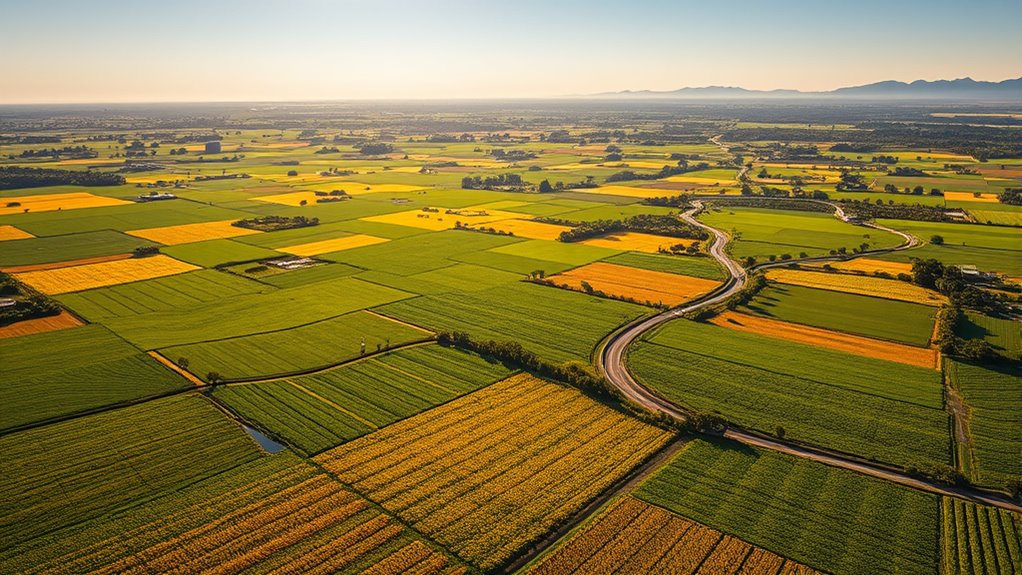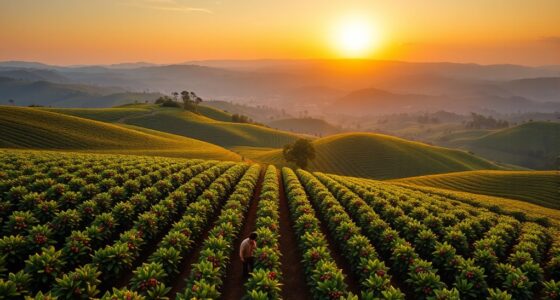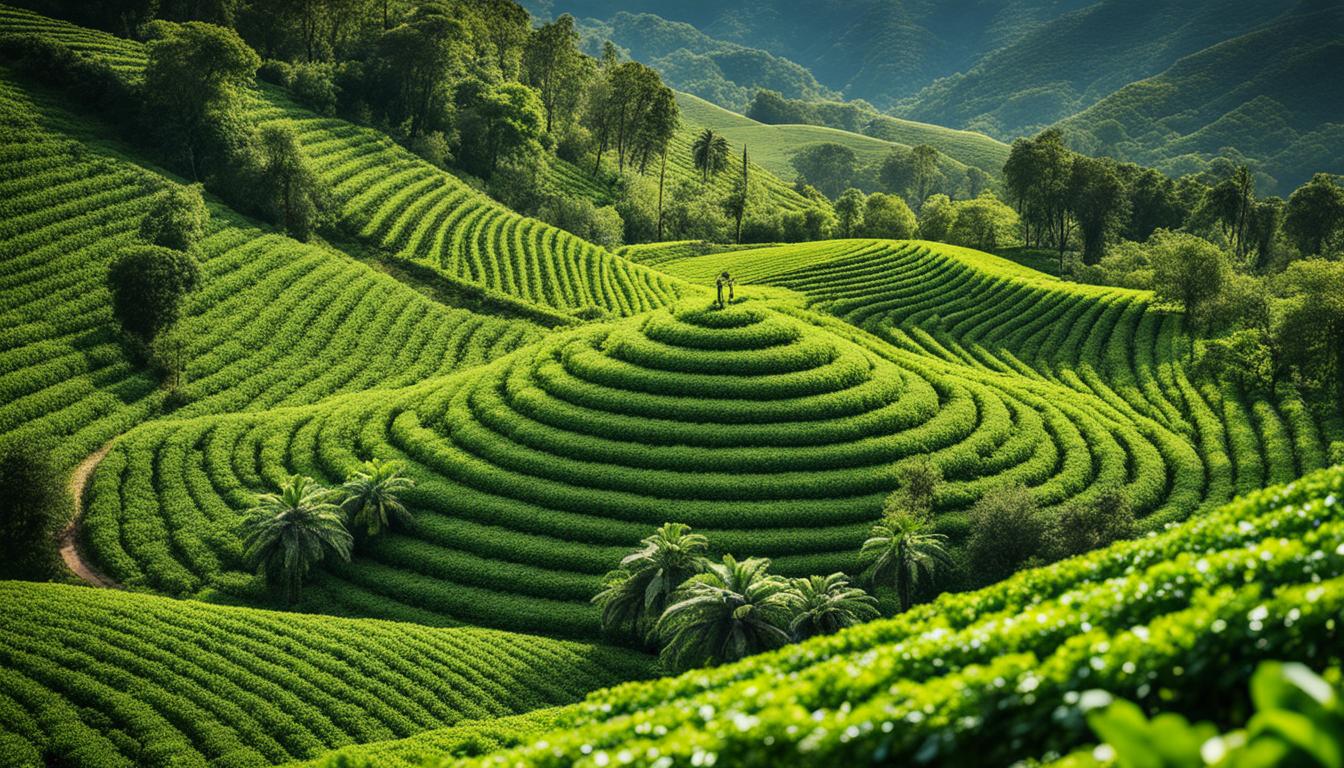For Brazil’s 2025–26 harvest, keep an eye on weather patterns like droughts or heavy rains, as they’ll influence yields and quality. Workforce shortages may cause delays and lower crop standards, especially during extreme conditions. You should also monitor climate predictions and labor availability, since these factors intertwine to shape harvest timing and output. Staying informed can help you understand the challenges ahead and what strategies may mitigate their impact. Continue to explore for more insights.
Key Takeaways
- Monitor seasonal weather forecasts and climate trends to anticipate impacts on planting, growth, and harvest timing.
- Assess potential labor shortages and explore automation or flexible workforce strategies to ensure timely harvesting.
- Evaluate the risk of droughts or heavy rains affecting crop quality, yields, and harvest windows.
- Diversify crops and planting schedules to mitigate climate variability and market uncertainties.
- Build contingency plans for extreme weather events and labor disruptions to minimize harvest losses.

As Brazil prepares for its 2025–26 harvest, farmers and industry experts are closely monitoring weather patterns and global demand to forecast output. This season’s success hinges on understanding how climate impact and labor shortages could influence crop yields. Climate conditions, especially irregular rainfall and rising temperatures, play a critical role in determining harvest quality and quantity. Droughts or excessive rainfall can damage crops, delay planting, or reduce overall yields, making weather unpredictability a top concern. You need to stay attentive to seasonal forecasts and long-term climate trends, as any deviation from normal conditions could considerably affect your harvest plans. Additionally, adopting high-precision agricultural techniques can help optimize resource use and improve resilience against climate variability.
Simultaneously, labor shortages remain a pressing challenge. As mechanization advances, some tasks become less labor-intensive, but many farm operations still depend heavily on seasonal workers. Brazil’s agricultural sector has faced difficulties attracting enough labor, especially during peak harvest periods. If labor shortages persist or worsen, you might experience delays in harvesting or a reduction in overall productivity. This can lead to lower-quality crops, increased costs, or missed market opportunities. To manage this, you should consider investing in more efficient machinery or exploring innovative labor solutions, such as temporary work programs or automation, to ensure your harvest stays on track.
Weather variability and labor issues are interconnected. For instance, a late or disrupted harvest caused by weather can coincide with labor shortages, compounding the risk of crop loss. If you’re unable to secure enough workers when needed, crops left unharvested can spoil or lose value. Additionally, climate impacts could also influence labor availability indirectly, as extreme weather events might affect worker mobility or safety, further complicating recruitment efforts.
Given these factors, your strategy should include contingency planning. Keep a close eye on weather forecasts and be prepared to adapt your schedule accordingly. Building relationships with local labor providers and considering automation options can help mitigate labor shortages. Additionally, diversifying your crops or planting schedules might reduce vulnerabilities caused by climate impact. Staying informed about global demand trends is equally essential, as shifts in export markets or commodity prices can influence your decisions on when and how much to harvest.
Frequently Asked Questions
How Will Climate Change Impact Brazil’s Harvest Yields?
Climate change will likely impact your harvest yields by causing climate-induced droughts and temperature fluctuations. These conditions can reduce crop growth and increase stress on plants, leading to lower productivity. You might see more inconsistent rainfall and hotter temperatures, which disrupt planting cycles and crop health. Staying adaptable and adopting resilient farming practices can help you mitigate these effects and protect your yields from the adverse impacts of climate change.
What New Technologies Are Being Adopted in Brazil’s Agriculture?
You see Brazil adopting new agriculture technologies like precision farming and drone technology to boost productivity and sustainability. Precision farming allows you to optimize input use, reducing waste and increasing yields. Drones help you monitor crop health, assess damage, and manage resources efficiently. These innovations enable you to make data-driven decisions, improve crop management, and adapt to changing climate conditions, ensuring a more resilient and profitable harvest.
How Are Global Trade Policies Affecting Brazil’s Exports?
You might think global trade policies are helping Brazil’s exports, but ironically, trade barriers and restrictions are tightening market access. These policies can slow down exports, making it harder for Brazil to capitalize on its agricultural growth. Instead of a smooth flow, you face hurdles that limit your ability to reach international markets easily. So, while Brazil’s harvest flourishes, global trade policies could be quietly holding back its full export potential.
What Are the Social Implications for Brazilian Farmers?
You might notice that social implications for Brazilian farmers include challenges to rural livelihoods and the strength of farmer communities. As global trade policies shift, you could see increased pressure on small-scale farmers, risking their economic stability. You’re likely to observe efforts to support these communities through government programs or cooperatives, aiming to preserve rural livelihoods and foster resilience within farmer networks amid changing market dynamics.
How Is Brazil Addressing Sustainability in Its Agriculture Sector?
Brazil’s tackling sustainability with gusto, or so it seems. You’ll find plenty of eco-friendly initiatives and sustainable practices cropping up, aiming to boost productivity while protecting the environment. They’re planting more native species, reducing deforestation, and embracing greener tech. It’s almost like they’re serious about balancing farming with nature—who knew? While challenges remain, Brazil’s efforts show a commitment to making agriculture both productive and sustainable.
Conclusion
As you follow Brazil’s 2025–26 harvest, keep an eye on weather patterns and technological advances—they might just be the game-changers. Some experts believe that a perfect storm of favorable conditions could boost yields unexpectedly, challenging traditional forecasts. So, don’t dismiss the possibility that this harvest could surprise everyone. Stay informed, because what happens in Brazil might just ripple through global markets and reshape your expectations for the year ahead.









